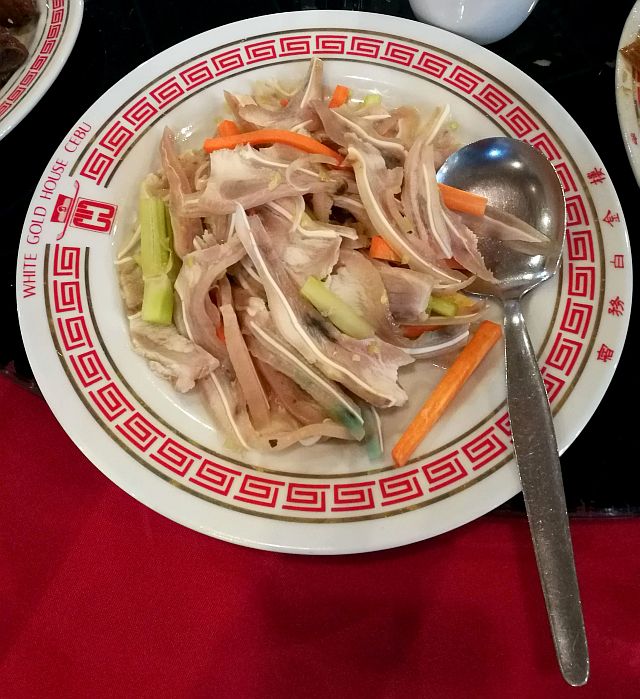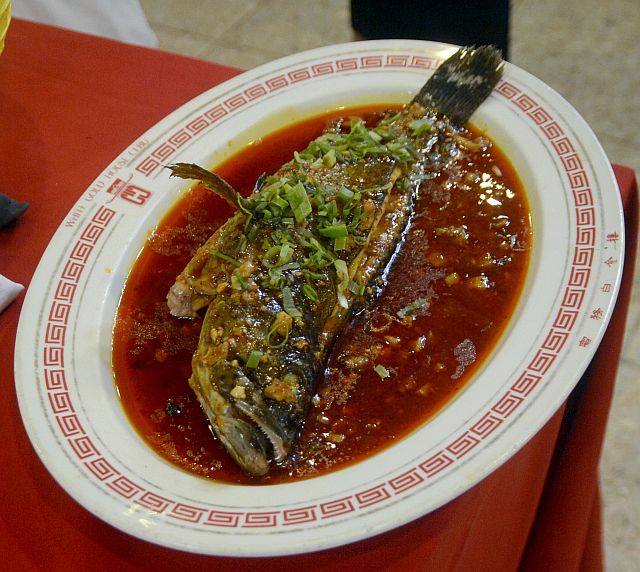
crunchy
Pork Ear
with Pepper
IT Was no dimsum night.
For huge servings of delectable Sichuan dishes—often characterized by their spicy and fiery taste—were served at the White Gold House for the celebratory dinner following the signing of the sister-city agreement between Cebu and Chengdu (mainland China).
Leading the Chengdu delegation was Mayor Luo Qiang who brought with him14 teachers, who shared their expertise on martial arts, calligraphy and dance to teachers and pupils of Cebu Cherish School.
But the most celebrated figures that night were Chinese chefs Xiong Jiangli and Chen Kongjian, who served local governmentofficials and foreign dignitaries with 15 dishes and two types of desserts with exception of the spicy lechon that Mayor Osmeña made available for the Chinese guests.
The chefs were shy but obliged to a photo opportunity with guests.
First served that evening were cold dishes of sweet and sour spare ribs, spicy beef, cold fresh vegetables and crunchy pork
ear with pepper.
The first three were common to the Cebuano diners of the roundtable that night.

Fish with Sichuan Tausi
But it was the last dish that made everyone adventurous and bold to try out the dish made up of—yes, obviously!—pig ears and pepper.
Its closest relative dish is the Chinese pig ear salad, which I got acquainted to in my trip to Chengdu, the capital of Sichuan province, four years ago. The chefs chose a plain and simple taste and presentation that night without the numbing quality of Sichuan style red oil combined with spring onions,corinander and sesame seeds.
One of my closest friends,Xie Shuang (English name: Grace), is a native of Chengdu who taught me how to appreciate Sichuancuisine, one of the eight greatregional cuisines of China.
The names of the dishes can be confusing but that night I had overseas culture officer of Chengdu municipal government Li Linxuan, who was patient enough to answer my questions delivered in my rusty Mandarin Chinese.
She explained that Sichuan dishes are famous for having its own distinct taste, unique and separate from other dishes.
Its cuisine has an ancient history dating back to the Ba and Shu countries in 300 BCE China. Thisis why Sichuan cuisine bears asignificant historical role in Chinese cuisine.
Continuing with the night’s feast, a variety of hot dishes arrived two and three at a time.
Pork with Pickled Vegetable
The crystal prawn with kung pau sauce became the instant favorite followed by the fish with Sichuan tausi. Different meat dishes of pork, chicken and beef followed. Meat ball with vegetable soup and boiled Chinese kale were served last.
Sichuan dishes are often characterized by its mala sauce: spicy, hot and numbing.
The ones served at the celebratory dinner was only five in a 1-to-10 mala scale, if I were to be asked to rate it. Perhaps it was done so the guests won’t cry and swear by the intensity of authentic Sichuan cuisine. It was after all a night of friendship and camaraderie.
With a sister-city agreement between Cebu and Chengdu, both mayors said they expect strong trade relations and economic ties between the two cities.
Last year, China Eastern Airlines launched a four-times-a-week direct flight from Chengdu to Cebu, bringing in more tourists from mainland China, according to Consul General Shi Yong ofthe Chinese Consulate in Cebu.Shi said the direct flight andsister-city agreement will bring in more Chinese companies to Cebu for opportunities and investments.
“The Philippines and China are neighbors enjoying traditional friendship. Chengdu brought in two chefs to shares to Cebu the Chinese cooking culture which will help the two cultures understand each other better,” Shi said.

